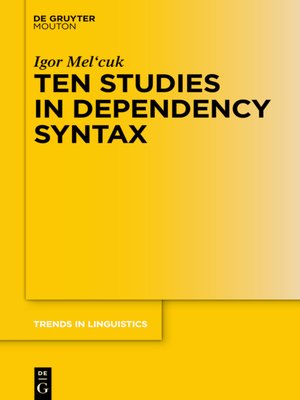Ten Studies in Dependency Syntax
ebook ∣ Trends in Linguistics. Studies and Monographs [TiLSM]
By Igor Mel'cuk

Sign up to save your library
With an OverDrive account, you can save your favorite libraries for at-a-glance information about availability. Find out more about OverDrive accounts.
Find this title in Libby, the library reading app by OverDrive.



Search for a digital library with this title
Title found at these libraries:
| Library Name | Distance |
|---|---|
| Loading... |
The monograph presents the Meaning-Text approach applied to the domain of syntax from a typological angle; it deals with several long-standing syntactic problems on the basis of a dependency description.
Its content can be presented in five parts + an Introduction:
The Introduction explains the architecture of the book and sketches the Meaning-Text linguis-tic model, underlying the subsequent discussion.
I. Surface-syntactic relations in the languages of the world, with special studies of subjects and objects.
II. Grammatical voice in the dependency framework: the "passive" construction in Chinese.
III. The relative clause: a calculus and analysis of possible types; the pseudo-relative ("headless") clause.
IV. Binary conjunctions (such as IF ..., THEN ...), free indefinite pronouns ([He went] nobody knows where), and syntactic idioms.
V. Word order: linearization of dependency structures.
The monograph offers a new perspective in syntactic studies. It is strongly typology-oriented (using the data from typologically diverse languages: English, Russian, Chinese, Korean, Basque, Georgian, etc.) and based on a system of rigorous definitions of the notions involved, which ensures a link with computational linguistics and Natural Language Processing
Its content can be presented in five parts + an Introduction:
The Introduction explains the architecture of the book and sketches the Meaning-Text linguis-tic model, underlying the subsequent discussion.
I. Surface-syntactic relations in the languages of the world, with special studies of subjects and objects.
II. Grammatical voice in the dependency framework: the "passive" construction in Chinese.
III. The relative clause: a calculus and analysis of possible types; the pseudo-relative ("headless") clause.
IV. Binary conjunctions (such as IF ..., THEN ...), free indefinite pronouns ([He went] nobody knows where), and syntactic idioms.
V. Word order: linearization of dependency structures.
The monograph offers a new perspective in syntactic studies. It is strongly typology-oriented (using the data from typologically diverse languages: English, Russian, Chinese, Korean, Basque, Georgian, etc.) and based on a system of rigorous definitions of the notions involved, which ensures a link with computational linguistics and Natural Language Processing







